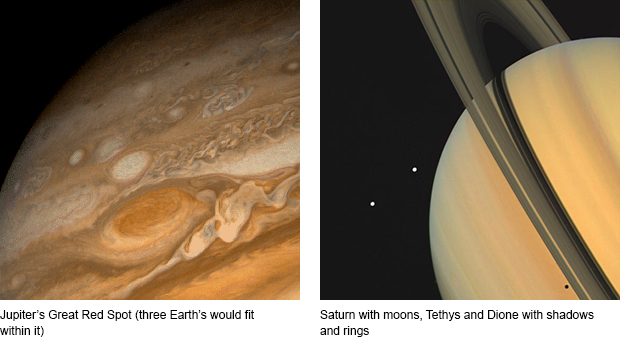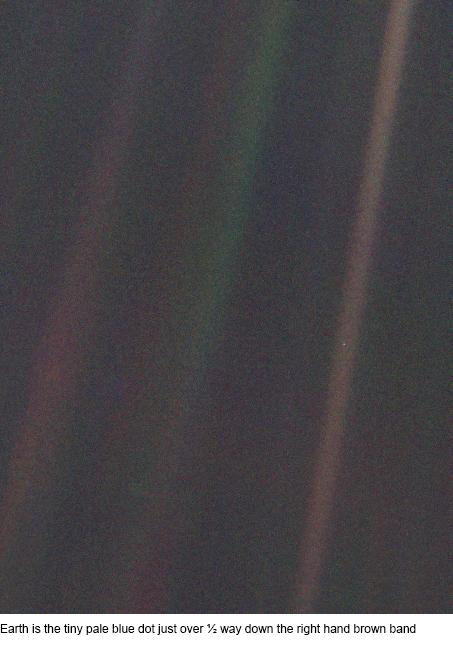Thursday 26 September 2013
In the words of the immortal Monty Python – “and now for something completely different” – some energy related thoughts on the amazing Voyager 1 spacecraft which it was recently reported has now “left the solar system”.
Voyager 1 was launched on 5th September 1977 with the aim of flying by Jupiter and Saturn, which it did so in 1979 and 1980 respectively. The photographs of the two gas giant planets were stunning and much better quality than those from the earlier Pioneer 10 and 11 probes.

I remember the great excitement of first seeing these photos. Voyager 1’s sister ship, Voyager 2 also flew by Jupiter and Saturn and then went on to fly past Uranus and Neptune. Pluto is the only planet we haven’t visited yet but all being well the New Horizons probe will get there in July 2015. As was widely reported it has now been confirmed that Voyager 1 passed through the heliopause and entered interstellar space in August 2012 although it turns out that defining the real edge of the solar system is harder than you would think. So far Voyager 1 has travelled about 125 Astronomical Units, i.e. 125 times the average distance from the Earth to the sun, or about 18,699,733,875 kilometres.
One fascinating energy aspect of the Voyager mission was the “gravity assist” technique used to accelerate the vehicle and change course and accelerate by using the gravity of Jupiter and then Saturn. Essentially the course selected ensured that the vehicle would be accelerated by the planet’s angular momentum. Without this technique it would have been impossible to get to Saturn. The fly by at Jupiter resulted in Voyager 1 being accelerated by roughly 35,700 miles per hour, an energy boost of about 25 MWh by my calculations. (Usually kinetic energy is measured in Joules but I have converted it to MWh as we can relate to MWh better than Joules). Of course we know that energy is always conserved so Jupiter lost the same amount of rotational energy but of course the planet is so massive, 317 times the mass of the Earth, that any effect on Jupiter won’t ever be noticed.
The energy to keep Voyager functioning comes from an three RTGs, radioisotope thermal generators, each of which uses 4.5 kilogrammes of radioactive plutonium 238 (238Pu) in the form of plutonium oxide which originally emitted 2.4 kW of heat which was converted to about 157W electricity by thermocouples – no moving parts, very simple and still working after 36 years. The output halves every 87 years as the radioactive material decays. The original 470W electrical output of the three RTGs combined is about half the rating of a domestic toaster. Interplanetary probes in the inner solar system, out to Mars, can use solar arrays but at Jupiter the sun is between 600 and 800 million kilometres away and the light level is only about 50W/m2 compared to 1,400W/m2 at Earth. Solar arrays would have to be enormous to generate sufficient power to run the spacecraft. As the radioactive plutonium in the RTGs decays so does the electrical power output. NASA have a sequence of switching things off and estimate there will be enough power to run some instruments up to the mid-2020s – nearly fifty years after launch. Although it is not widely known as an earth-bound energy generation technology several companies are developing thermocouples (not linked to using radioisotopes) to use different low temperature heat sources to generate power, for example O-flexx. If they can make them cheap enough and they can operate at low enough temperatures there will be a market in utilising waste heat sources to generate power.
The fact that we are still receiving information from Voyager is a testament to the brilliance of radio engineering, an area of technology I always struggle with. Here we have a probe that is 18 billion kilometres away, it’s radio transmitter emits radio waves with a power output of 23W, (compared to a mobile phone that typically emits c.3W), through a 3.7m parabolic dish antenna,. By the time it gets to earth after a 17 hour trip the radio wave has a power of one tenth of a billion-billionth watt and somehow this tiny signal is picked up by the Deep Space Network’s giant receivers and turned into useful information – there is no other word for that than amazing.
At the other end of the scale when it comes to radio waves is the enormous amount of energy put out by Jupiter. Strangely Jupiter emits more energy than it receives from the sun and the total emission in radio, near Infra-Red, Ultra Violet and X-ray is estimated at 100TW – about 100 times the total US electrical generating capacity.
In summary there are many amazing things about Voyager, its mission and the outer solar system. The technology of Voyager by today’s standards is incredibly primitive, data is stored on a tape recorder of sorts with 69 kilobytes (yes – kilobytes) capacity. The navigation required to thread accurately through to Jupiter, Saturn and beyond is incredible. The mere fact that we have sent an emissary out that far speaks volumes for man’s vision, ingenuity and our innate drive to explore.
Finally, one of the most awesome photos taken by Voyager was the famous “pale blue dot” photo – a shot of Earth taken from 6 billion kilometres away which shows the Earth as simply that, a pale blue dot in the vastness of space.

Carl Sagan, the great astronomer, who had been instrumental in getting NASA to command Voyager 1 to take this photograph later wrote about it:
From this distant vantage point, the Earth might not seem of any particular interest. But for us, it’s different. Consider again that dot. That’s here. That’s home. That’s us. On it everyone you love, everyone you know, everyone you ever heard of, every human being who ever was, lived out their lives. The aggregate of our joy and suffering, thousands of confident religions, ideologies, and economic doctrines, every hunter and forager, every hero and coward, every creator and destroyer of civilization, every king and peasant, every young couple in love, every mother and father, hopeful child, inventor and explorer, every teacher of morals, every corrupt politician, every “superstar,” every “supreme leader,” every saint and sinner in the history of our species lived there – on a mote of dust suspended in a sunbeam.
The Earth is a very small stage in a vast cosmic arena. Think of the rivers of blood spilled by all those generals and emperors so that in glory and triumph they could become the momentary masters of a fraction of a dot. Think of the endless cruelties visited by the inhabitants of one corner of this pixel on the scarcely distinguishable inhabitants of some other corner. How frequent their misunderstandings, how eager they are to kill one another, how fervent their hatreds. Our posturings, our imagined self-importance, the delusion that we have some privileged position in the universe, are challenged by this point of pale light. Our planet is a lonely speck in the great enveloping cosmic dark. In our obscurity – in all this vastness – there is no hint that help will come from elsewhere to save us from ourselves.
The Earth is the only world known, so far, to harbor life. There is nowhere else, at least in the near future, to which our species could migrate. Visit, yes. Settle, not yet. Like it or not, for the moment, the Earth is where we make our stand. It has been said that astronomy is a humbling and character-building experience. There is perhaps no better demonstration of the folly of human conceits than this distant image of our tiny world. To me, it underscores our responsibility to deal more kindly with one another and to preserve and cherish the pale blue dot, the only home we’ve ever known.
– Carl Sagan, Pale Blue Dot: A Vision of the Human Future in Space, 1997
It is worth taking the big picture view sometimes.
For those of you who don’t know my other great interest in life is space exploration and space travel. Normal service will be resumed on the next blog post.
Comments
Comments are closed.
Dr Steven Fawkes
Welcome to my blog on energy efficiency and energy efficiency financing. The first question people ask is why my blog is called 'only eleven percent' - the answer is here. I look forward to engaging with you!
Email notifications
Receive an email every time something new is posted on the blog
Tag cloud
Black & Veatch Building technologies Caludie Haignere China Climate co-benefits David Cameron E.On EDF EDF Pulse awards Emissions Energy Energy Bill Energy Efficiency Energy Efficiency Mission energy security Environment Europe FERC Finance Fusion Government Henri Proglio innovation Innovation Gateway investment in energy Investor Confidence Project Investors Jevons paradox M&V Management net zero new technology NorthWestern Energy Stakeholders Nuclear Prime Minister RBS renewables Research survey Technology uk energy policy US USA Wind farmsMy latest entries


